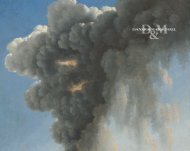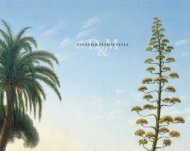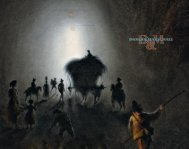Catalogue 2010 - daxer & marschall
Catalogue 2010 - daxer & marschall
Catalogue 2010 - daxer & marschall
You also want an ePaper? Increase the reach of your titles
YUMPU automatically turns print PDFs into web optimized ePapers that Google loves.
THOMAS FEARNLEY<br />
Derwentwater in Borrowdale, Looking South<br />
Thomas Fearnley<br />
(Frederikshald 1802 - 1842 Munich)<br />
Derwentwater in Borrowdale,<br />
Looking South, 1837<br />
Oil on paper, laid down on canvas<br />
Signed, dated and inscribed lower<br />
right TF 29 Aug. 37. Derwent Water<br />
28 x 39 cm<br />
38<br />
Fearnley set off on a visit to the Lake District in north-western England in early August 1837. He<br />
spent six weeks in the area in the company of the English painter Charles West Cope, a good friend<br />
from his sojourn in Italy. 1 An approximate reconstruction of the route they took can be made on<br />
the basis of oil studies executed by Fearnley – many of them are precisely dated and topographically<br />
annotated. 2<br />
In August and September of 1837, the two painters stayed in Borrowdale, a Lake District<br />
valley much loved by the Romantic poets. The river Derwent flows through the valley in a northerly<br />
direction, continuing on through the lake known as Derwentwater at the lower end of the valley.<br />
It is here that the present oil study was executed. The art historian Marit Lange, in her examination<br />
of Fearnley’s oil studies, describes the landscapes he produced directly before the motif at Derwentwater<br />
as ‘some of his most brilliant studies from nature’. 3<br />
The study is dated very precisely 29 Aug.’37. 4 It depicts the view from Keswick looking<br />
south over Derwentwater and Borrowdale. In the distance are the rocky crags, high fells and peaks<br />
characteristic of the Lake District.<br />
Most of the studies Fearnley executed in the Lake District were small in format. They display<br />
a highly sensitive response to the wild landscapes of the region, the damp climate and the volatile<br />
weather conditions. His handling of the play of light and shade in the banks of cloud whipping<br />
across the sky is masterly.<br />
1. Charles West Cope (1811-90) describes his Italian journey with Thomas Fearnley in his Reminiscences. In 1832, Fearnley moved to Rome<br />
and travelled in Italy until 1835, keeping company with Berthel Thorvaldsen and his circle of Danish and German artists in Rome.<br />
2. Sigurd Willoch, Maleren Thomas Fearnley, Oslo 1932, pp. 164-8 and p. 253. Fearnley met Cope in Dentdale and stayed near Ambleside<br />
and Rydal from 10-28 August before travelling northwards. He visited Wastwater and Coniston. After his stay near Derwentwater he was<br />
in ullswater and Patterdale, where he was still painting on 13 September. After that, the record peters out.<br />
3. Nature’s Way. Romantic Landscapes from Norway. Oil studies, watercolours and drawings by Johan Christian Dahl and Thomas Fearnley, exhib. cat.,<br />
Cambridge, Fitzwilliam Museum 1993, p. 55.<br />
4. Further studies in the group are: Cannon at Ladore, Derwentwater, oil on paper on canvas, 26.5 x 39 cm, signed, dated and inscribed lower<br />
right Low Door Cumberland 3 Sept 37 F., Nasjonalgalleriet Oslo NG.M.2333; Rocks Covered by Heather, see p.40 of the present catalogue;<br />
Borrowdale, inscribed and dated 3 Sept. 1837, private collection, see Willoch, op. cit., repr. p.168; Fisherman at Derwentwater, 27 x 39.5<br />
cm, 1837, signed TF.PE, see Thomas Fearnley, 1802-1842, exhib. cat., Modum, Stiftelsen Modums Blaafarveværk, 1986, no. 90, repr. in<br />
colour p. 67.






